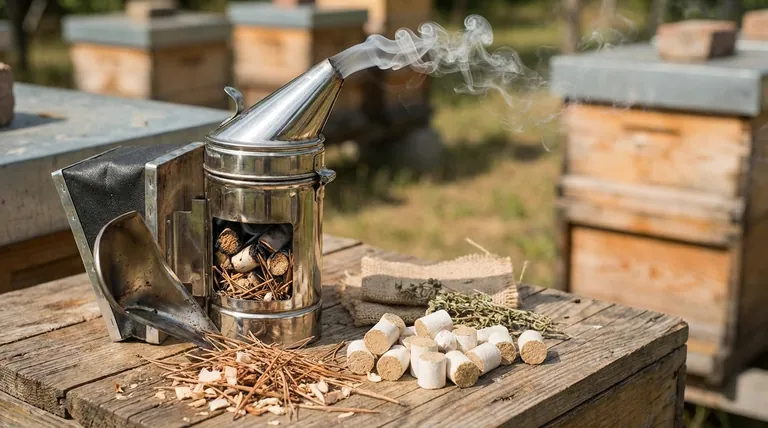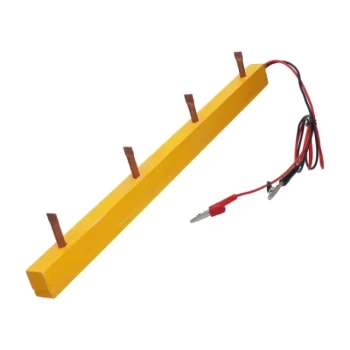In a bee smoker, you burn natural, untreated, and dry materials that smolder slowly to produce a cool, white smoke. Common and effective fuels include dried pine needles, untreated burlap, commercial cotton pellets, wood shavings, and dry grass or hay. The goal is to create a calm, persistent smoke rather than a hot, active fire.
The most critical factor is not the specific fuel you choose, but its characteristics: it must be natural, completely dry, and capable of smoldering slowly. The purpose is to generate cool, calming smoke to mask alarm pheromones, not hot smoke that could harm or agitate the bees.

The Principle: How a Bee Smoker Creates Calm
To understand what to burn, you must first understand how a smoker is designed to work. It is not a miniature furnace; it is a specialized tool for controlled, low-temperature combustion.
The Fire Chamber: Engineered for Slow Smoldering
A bee smoker's fire chamber, often a metal canister, is designed to hold fuel and restrict airflow.
This low-oxygen environment prevents the fuel from bursting into open flame. Instead, it encourages a slow, smoldering burn that can last for a long time.
The Bellows: Oxygen On-Demand
The attached bellows are the engine of the smoker. Each pump injects a small puff of oxygen into the fire chamber.
This targeted airflow briefly intensifies the smoldering process, forcing a thick, cool puff of smoke out of the nozzle. This gives you precise control over when and how much smoke you apply.
Choosing the Right Smoker Fuel
Fuels can be broken down into two categories: starters to get the fire going and primary fuels to create the long-lasting smoke.
Starter Fuels (Kindling)
Your first goal is to establish a small, stable ember. Lighter materials are perfect for this.
Good starters include crumpled newspaper, cardboard egg cartons, or small pieces of untreated burlap. Their job is simply to ignite easily and burn long enough to light the main fuel.
Primary Fuels (The Main Event)
Once you have an ember, you add the main fuel source on top. These materials are denser and burn much more slowly.
- Dried Pine Needles: A classic choice. They are widely available, light easily, and produce a pleasant-smelling, gentle smoke.
- Untreated Burlap or Cotton: Often sold as commercial smoker fuel, these materials are excellent. They pack densely, smolder for a very long time, and produce a reliable, cool smoke.
- Wood Shavings: Kiln-dried shavings (not sawdust) work well. Ensure they are from untreated wood.
- Dry Grass or Hay: A readily available option, especially around farms. Ensure it is completely dry to avoid a steamy, ineffective smoke.
- Dried Herbs: Some beekeepers add dried herbs like lavender or mint for a pleasant aroma, though this is not required.
Understanding the Trade-offs and Pitfalls
Choosing the wrong fuel is not just ineffective—it can be dangerous for you and your bees. The goal is always cool, clean smoke.
Avoid All Treated or Synthetic Materials
Never burn wood pellets designed for heating, pressure-treated wood, painted or stained materials, or any form of plastic.
These materials release toxic chemicals and fumes that can poison your bees, contaminate your honey, and harm your own health.
Wet or "Green" Fuel Is Counterproductive
Fuel that contains moisture is difficult to light and keep smoldering.
Instead of producing cool smoke, it will generate a hot, wet steam that agitates bees and can introduce excess moisture into the hive. Always use materials that are bone-dry.
Fast-Burning Fuels Create Fire Hazards
Avoid materials that burn too hot and fast, like very dry leaves or paper used as a primary fuel.
These can create sparks or embers that fly out of the smoker, posing a fire risk. They also produce hot smoke and require constant refilling.
Making the Right Choice for Your Goal
Select your fuel based on your environment and beekeeping needs. A good beekeeper often uses a combination of materials.
- If your primary focus is cost and availability: Use readily available materials from your property, such as dried pine needles, grass, or hay.
- If your primary focus is a long-lasting, cool smoke for large apiaries: Invest in commercial cotton fuel or untreated burlap rolls that you can cut to size.
- If you are a beginner seeking a reliable combination: Start with a piece of newspaper as your kindling, then add a handful of dry pine needles on top for a predictable and easy-to-manage smoke.
Mastering your smoker is a foundational skill that transforms hive inspections from a stressful event into a calm, controlled process.
Summary Table:
| Fuel Type | Examples | Key Characteristics | Best For |
|---|---|---|---|
| Starter Fuels | Crumpled newspaper, cardboard | Ignites easily to create initial embers | Getting the smoker lit |
| Primary Fuels | Dried pine needles, untreated burlap, cotton pellets, wood shavings | Natural, dry, slow-smoldering | Long-lasting, cool, calming smoke |
| Fuels to Avoid | Treated wood, plastics, wet/green materials | Releases toxins, burns hot, or produces steam | Avoid at all costs |
Ensure Calm, Productive Hive Inspections with the Right Equipment
For commercial apiaries and distributors, consistent, reliable equipment is key to operational success. A well-fueled smoker is just one part of the equation. HONESTBEE supplies beekeepers with the high-quality, durable supplies and equipment needed for efficient, large-scale beekeeping.
Ready to equip your operation for peak performance? Contact HONESTBEE today to discuss our wholesale-focused solutions for commercial beekeepers and distributors.
Visual Guide

Related Products
- 54-Piece Smoker Fuel Pellets for Beekeeping Beehive Smoker Fuel
- Economy Galvanized Beekeeping Honey Bee Smoker for Wholesale
- Premium Traditional Copper Bee Smoker with Bellows
- Stainless Steel Honey Bee Smoker Hive and Honeycomb Smoker for Beekeeping
- European Stainless Steel Bee Smoker for Honey Bee Hive
People Also Ask
- How should you start the fire in a bee smoker? A Step-by-Step Guide for a Calm Hive
- What fuels are recommended for beehive smokers? Master the Art of Calm, Controlled Inspections
- What is used in a bee smoker? Master the Best Fuels for Calm, Healthy Hives
- What are important considerations when choosing smoker fuel? A Guide to Safe, Effective Beekeeping
- What can I use for bee smoker fuel? Choose Safe, Natural Materials for a Calm Hive



















